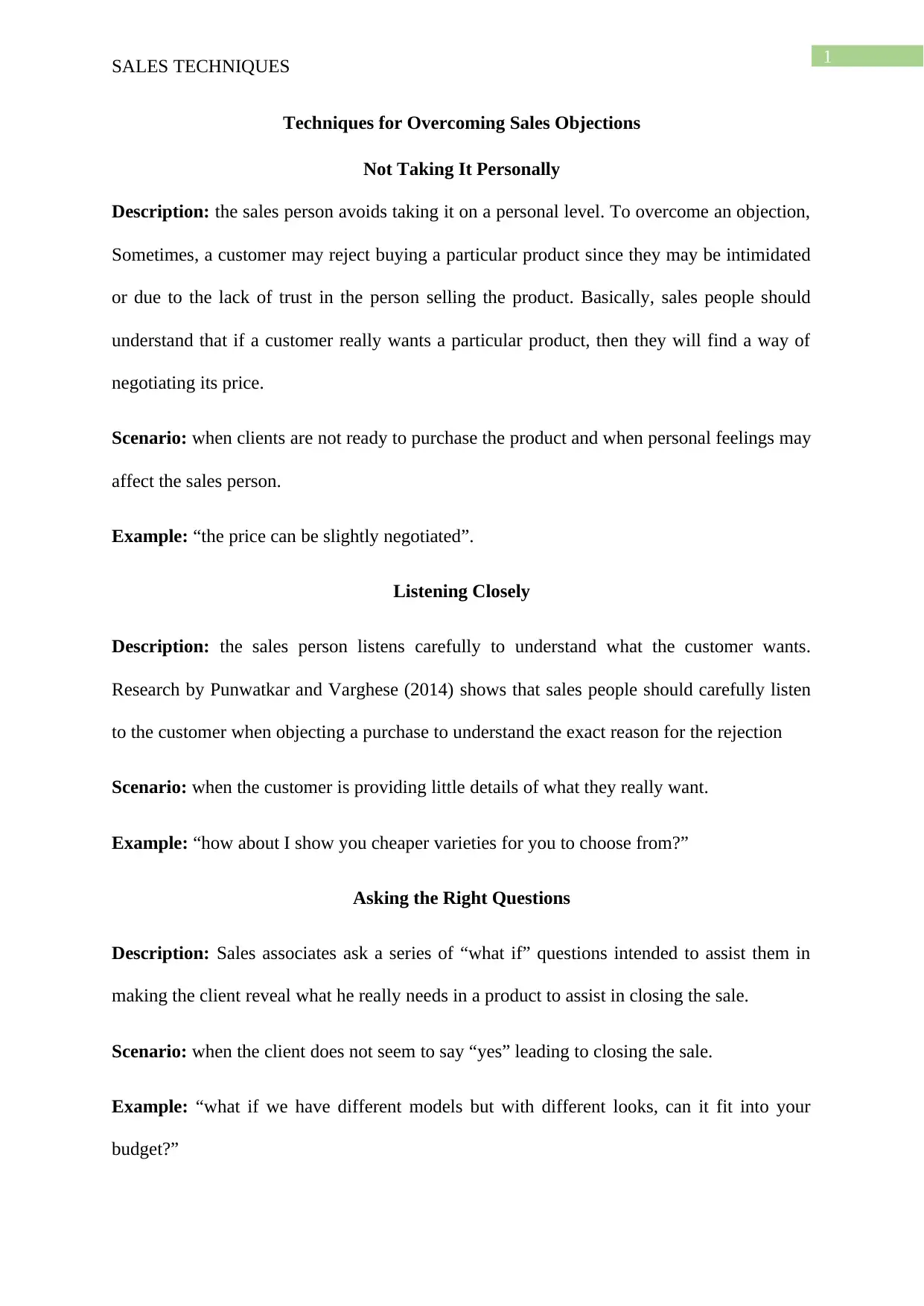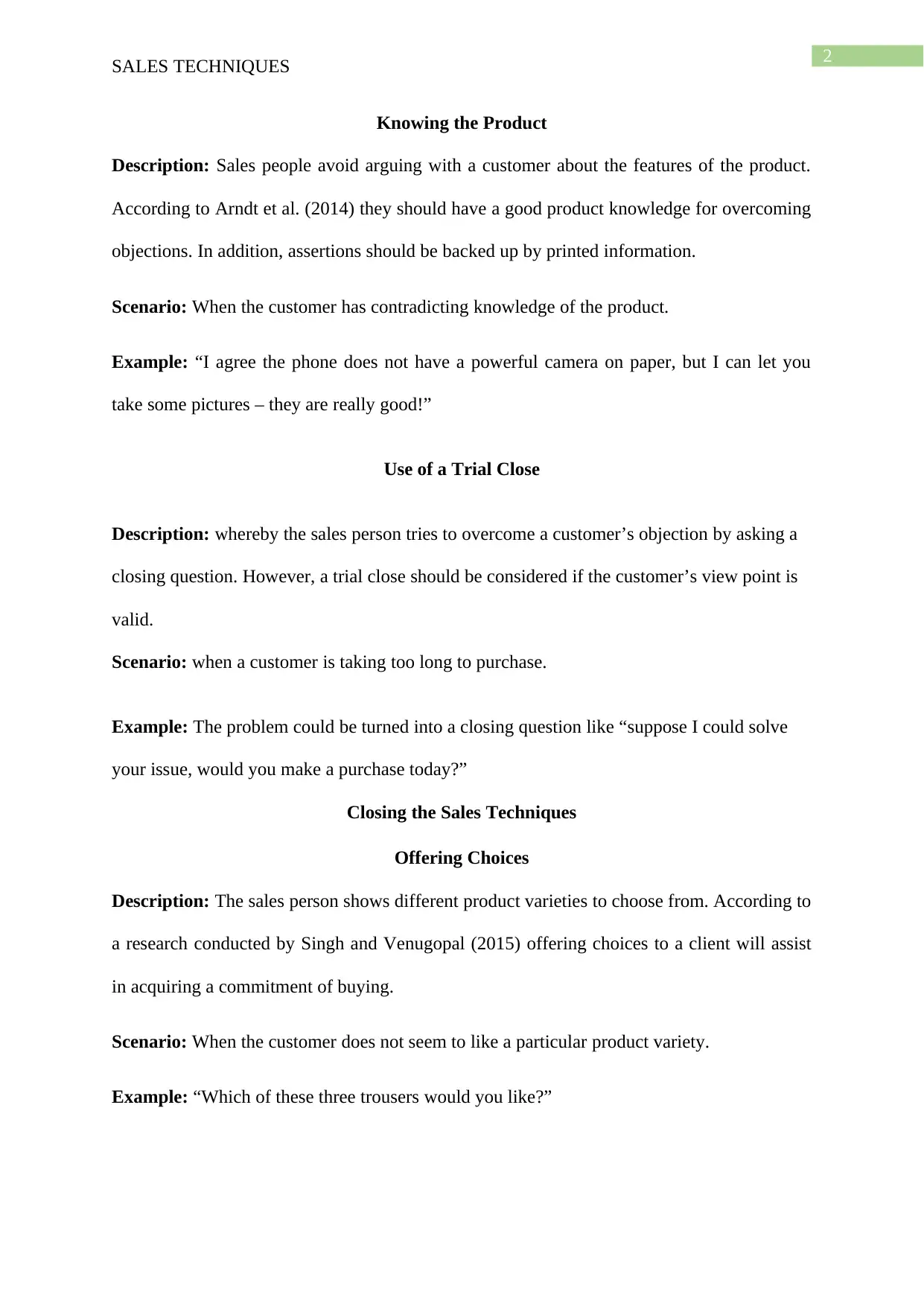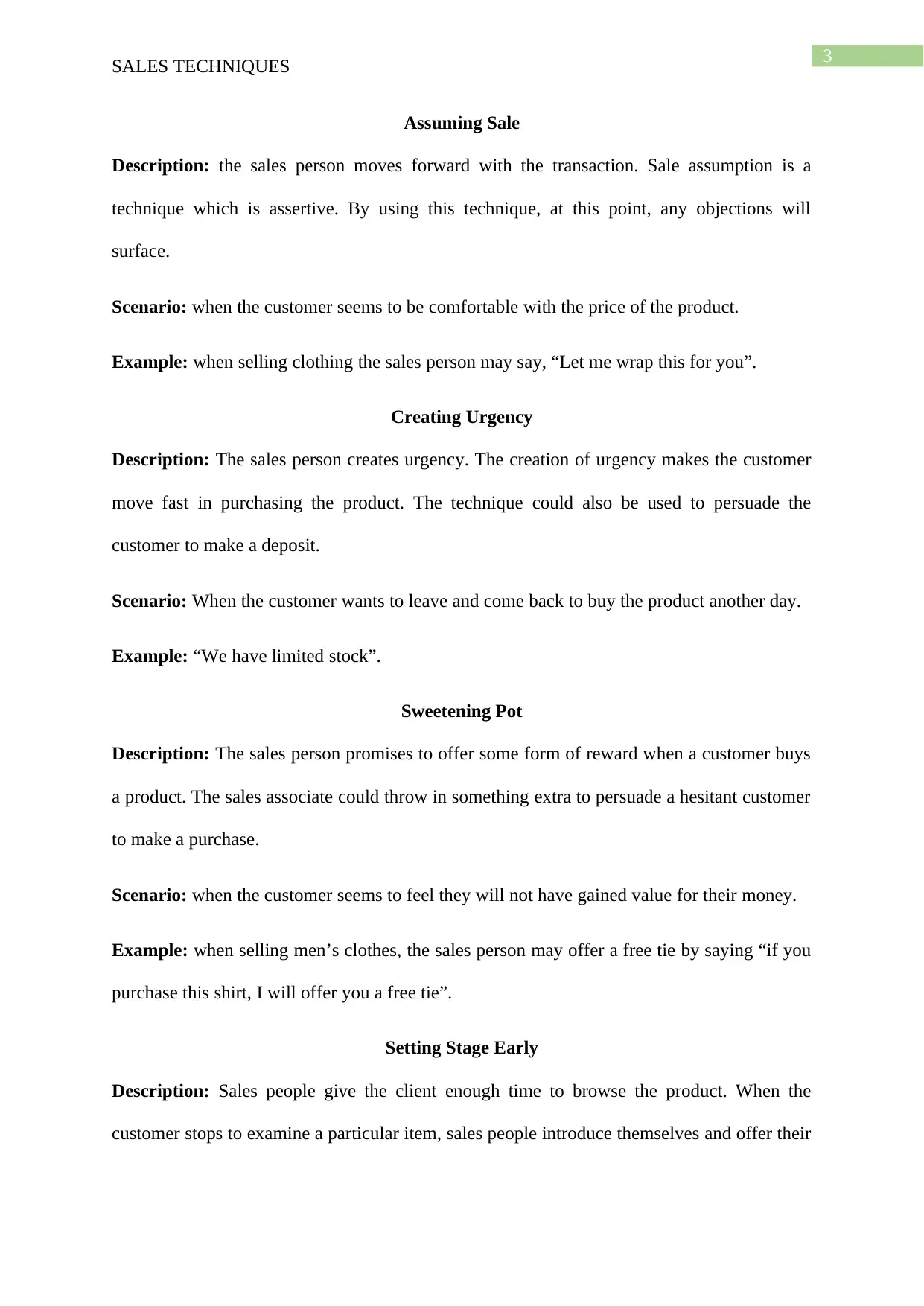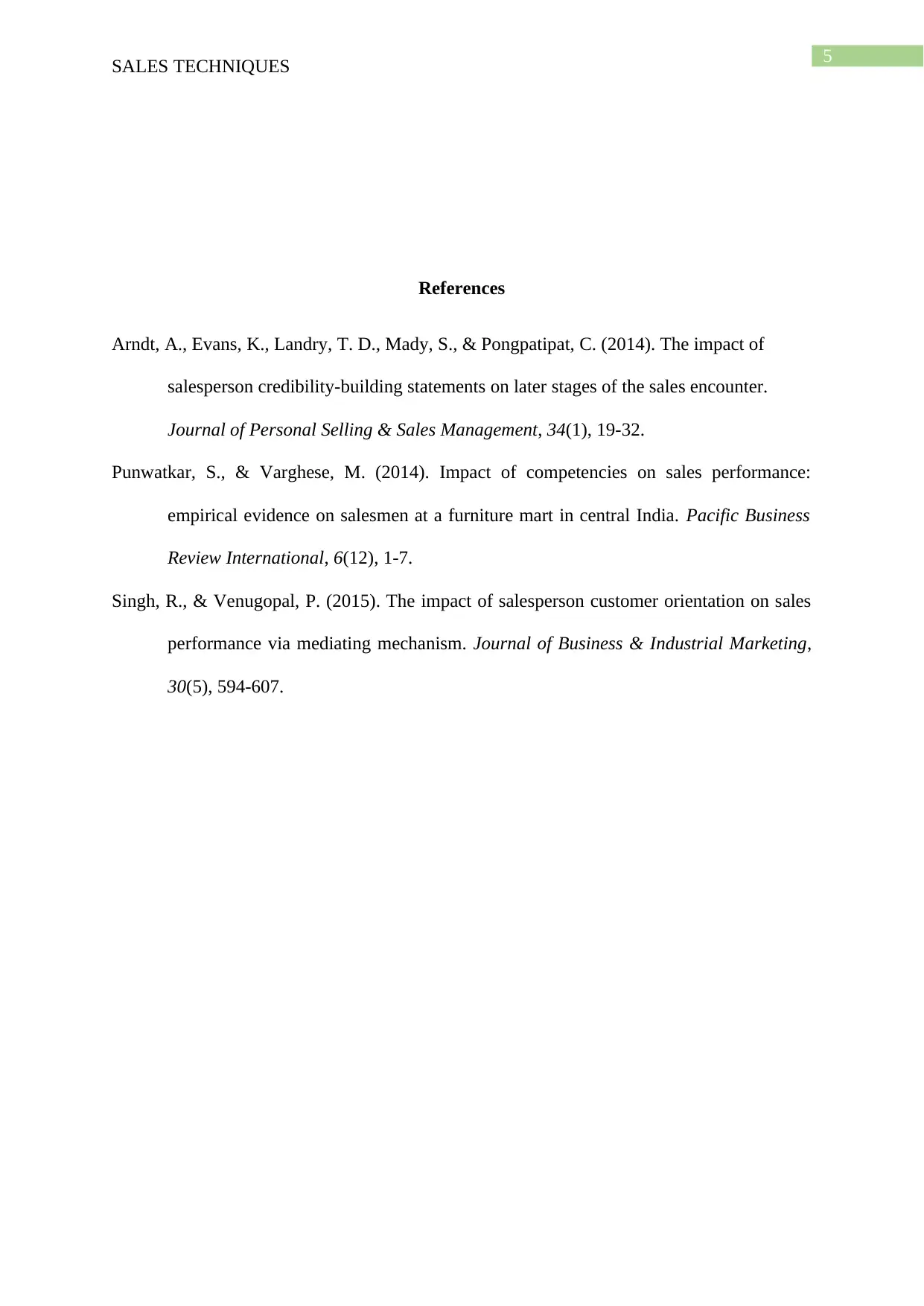Effective Sales Techniques: Overcoming Objections & Closing Sales
VerifiedAdded on 2023/04/17
|6
|834
|252
Report
AI Summary
This report identifies and describes various techniques for overcoming sales objections and closing sales. It covers strategies such as not taking objections personally, listening closely to customer needs, asking the right questions to uncover hidden needs, and leveraging product knowledge to address concerns. Closing techniques discussed include offering choices, assuming the sale, creating urgency, sweetening the pot with incentives, and setting the stage early through initial engagement. Each technique is illustrated with practical examples and scenarios to demonstrate their effective application in real-world sales situations. References to relevant research are included to support the effectiveness of the discussed techniques. Desklib offers a range of study tools, including past papers and solved assignments.

Running head: SALES TECHNIQUES
Sales Techniques
Name
Student ID
Unit
Institutional affiliation
Sales Techniques
Name
Student ID
Unit
Institutional affiliation
Paraphrase This Document
Need a fresh take? Get an instant paraphrase of this document with our AI Paraphraser

1
SALES TECHNIQUES
Techniques for Overcoming Sales Objections
Not Taking It Personally
Description: the sales person avoids taking it on a personal level. To overcome an objection,
Sometimes, a customer may reject buying a particular product since they may be intimidated
or due to the lack of trust in the person selling the product. Basically, sales people should
understand that if a customer really wants a particular product, then they will find a way of
negotiating its price.
Scenario: when clients are not ready to purchase the product and when personal feelings may
affect the sales person.
Example: “the price can be slightly negotiated”.
Listening Closely
Description: the sales person listens carefully to understand what the customer wants.
Research by Punwatkar and Varghese (2014) shows that sales people should carefully listen
to the customer when objecting a purchase to understand the exact reason for the rejection
Scenario: when the customer is providing little details of what they really want.
Example: “how about I show you cheaper varieties for you to choose from?”
Asking the Right Questions
Description: Sales associates ask a series of “what if” questions intended to assist them in
making the client reveal what he really needs in a product to assist in closing the sale.
Scenario: when the client does not seem to say “yes” leading to closing the sale.
Example: “what if we have different models but with different looks, can it fit into your
budget?”
SALES TECHNIQUES
Techniques for Overcoming Sales Objections
Not Taking It Personally
Description: the sales person avoids taking it on a personal level. To overcome an objection,
Sometimes, a customer may reject buying a particular product since they may be intimidated
or due to the lack of trust in the person selling the product. Basically, sales people should
understand that if a customer really wants a particular product, then they will find a way of
negotiating its price.
Scenario: when clients are not ready to purchase the product and when personal feelings may
affect the sales person.
Example: “the price can be slightly negotiated”.
Listening Closely
Description: the sales person listens carefully to understand what the customer wants.
Research by Punwatkar and Varghese (2014) shows that sales people should carefully listen
to the customer when objecting a purchase to understand the exact reason for the rejection
Scenario: when the customer is providing little details of what they really want.
Example: “how about I show you cheaper varieties for you to choose from?”
Asking the Right Questions
Description: Sales associates ask a series of “what if” questions intended to assist them in
making the client reveal what he really needs in a product to assist in closing the sale.
Scenario: when the client does not seem to say “yes” leading to closing the sale.
Example: “what if we have different models but with different looks, can it fit into your
budget?”

2
SALES TECHNIQUES
Knowing the Product
Description: Sales people avoid arguing with a customer about the features of the product.
According to Arndt et al. (2014) they should have a good product knowledge for overcoming
objections. In addition, assertions should be backed up by printed information.
Scenario: When the customer has contradicting knowledge of the product.
Example: “I agree the phone does not have a powerful camera on paper, but I can let you
take some pictures – they are really good!”
Use of a Trial Close
Description: whereby the sales person tries to overcome a customer’s objection by asking a
closing question. However, a trial close should be considered if the customer’s view point is
valid.
Scenario: when a customer is taking too long to purchase.
Example: The problem could be turned into a closing question like “suppose I could solve
your issue, would you make a purchase today?”
Closing the Sales Techniques
Offering Choices
Description: The sales person shows different product varieties to choose from. According to
a research conducted by Singh and Venugopal (2015) offering choices to a client will assist
in acquiring a commitment of buying.
Scenario: When the customer does not seem to like a particular product variety.
Example: “Which of these three trousers would you like?”
SALES TECHNIQUES
Knowing the Product
Description: Sales people avoid arguing with a customer about the features of the product.
According to Arndt et al. (2014) they should have a good product knowledge for overcoming
objections. In addition, assertions should be backed up by printed information.
Scenario: When the customer has contradicting knowledge of the product.
Example: “I agree the phone does not have a powerful camera on paper, but I can let you
take some pictures – they are really good!”
Use of a Trial Close
Description: whereby the sales person tries to overcome a customer’s objection by asking a
closing question. However, a trial close should be considered if the customer’s view point is
valid.
Scenario: when a customer is taking too long to purchase.
Example: The problem could be turned into a closing question like “suppose I could solve
your issue, would you make a purchase today?”
Closing the Sales Techniques
Offering Choices
Description: The sales person shows different product varieties to choose from. According to
a research conducted by Singh and Venugopal (2015) offering choices to a client will assist
in acquiring a commitment of buying.
Scenario: When the customer does not seem to like a particular product variety.
Example: “Which of these three trousers would you like?”
⊘ This is a preview!⊘
Do you want full access?
Subscribe today to unlock all pages.

Trusted by 1+ million students worldwide

3
SALES TECHNIQUES
Assuming Sale
Description: the sales person moves forward with the transaction. Sale assumption is a
technique which is assertive. By using this technique, at this point, any objections will
surface.
Scenario: when the customer seems to be comfortable with the price of the product.
Example: when selling clothing the sales person may say, “Let me wrap this for you”.
Creating Urgency
Description: The sales person creates urgency. The creation of urgency makes the customer
move fast in purchasing the product. The technique could also be used to persuade the
customer to make a deposit.
Scenario: When the customer wants to leave and come back to buy the product another day.
Example: “We have limited stock”.
Sweetening Pot
Description: The sales person promises to offer some form of reward when a customer buys
a product. The sales associate could throw in something extra to persuade a hesitant customer
to make a purchase.
Scenario: when the customer seems to feel they will not have gained value for their money.
Example: when selling men’s clothes, the sales person may offer a free tie by saying “if you
purchase this shirt, I will offer you a free tie”.
Setting Stage Early
Description: Sales people give the client enough time to browse the product. When the
customer stops to examine a particular item, sales people introduce themselves and offer their
SALES TECHNIQUES
Assuming Sale
Description: the sales person moves forward with the transaction. Sale assumption is a
technique which is assertive. By using this technique, at this point, any objections will
surface.
Scenario: when the customer seems to be comfortable with the price of the product.
Example: when selling clothing the sales person may say, “Let me wrap this for you”.
Creating Urgency
Description: The sales person creates urgency. The creation of urgency makes the customer
move fast in purchasing the product. The technique could also be used to persuade the
customer to make a deposit.
Scenario: When the customer wants to leave and come back to buy the product another day.
Example: “We have limited stock”.
Sweetening Pot
Description: The sales person promises to offer some form of reward when a customer buys
a product. The sales associate could throw in something extra to persuade a hesitant customer
to make a purchase.
Scenario: when the customer seems to feel they will not have gained value for their money.
Example: when selling men’s clothes, the sales person may offer a free tie by saying “if you
purchase this shirt, I will offer you a free tie”.
Setting Stage Early
Description: Sales people give the client enough time to browse the product. When the
customer stops to examine a particular item, sales people introduce themselves and offer their
Paraphrase This Document
Need a fresh take? Get an instant paraphrase of this document with our AI Paraphraser

4
SALES TECHNIQUES
assistance to the customer. Setting stage early could be brought about by the use of initial
sales approaches.
Scenario: when customers are doing window shopping as it could lead to an instant
purchase.
Example: “What problem would you like the product to solve for you?”
SALES TECHNIQUES
assistance to the customer. Setting stage early could be brought about by the use of initial
sales approaches.
Scenario: when customers are doing window shopping as it could lead to an instant
purchase.
Example: “What problem would you like the product to solve for you?”

5
SALES TECHNIQUES
References
Arndt, A., Evans, K., Landry, T. D., Mady, S., & Pongpatipat, C. (2014). The impact of
salesperson credibility-building statements on later stages of the sales encounter.
Journal of Personal Selling & Sales Management, 34(1), 19-32.
Punwatkar, S., & Varghese, M. (2014). Impact of competencies on sales performance:
empirical evidence on salesmen at a furniture mart in central India. Pacific Business
Review International, 6(12), 1-7.
Singh, R., & Venugopal, P. (2015). The impact of salesperson customer orientation on sales
performance via mediating mechanism. Journal of Business & Industrial Marketing,
30(5), 594-607.
SALES TECHNIQUES
References
Arndt, A., Evans, K., Landry, T. D., Mady, S., & Pongpatipat, C. (2014). The impact of
salesperson credibility-building statements on later stages of the sales encounter.
Journal of Personal Selling & Sales Management, 34(1), 19-32.
Punwatkar, S., & Varghese, M. (2014). Impact of competencies on sales performance:
empirical evidence on salesmen at a furniture mart in central India. Pacific Business
Review International, 6(12), 1-7.
Singh, R., & Venugopal, P. (2015). The impact of salesperson customer orientation on sales
performance via mediating mechanism. Journal of Business & Industrial Marketing,
30(5), 594-607.
⊘ This is a preview!⊘
Do you want full access?
Subscribe today to unlock all pages.

Trusted by 1+ million students worldwide
1 out of 6
Related Documents
Your All-in-One AI-Powered Toolkit for Academic Success.
+13062052269
info@desklib.com
Available 24*7 on WhatsApp / Email
![[object Object]](/_next/static/media/star-bottom.7253800d.svg)
Unlock your academic potential
Copyright © 2020–2025 A2Z Services. All Rights Reserved. Developed and managed by ZUCOL.





